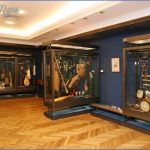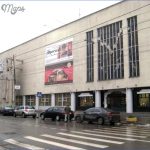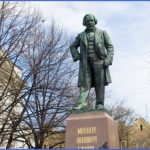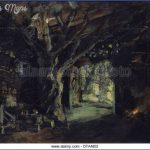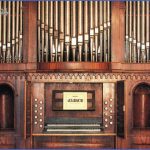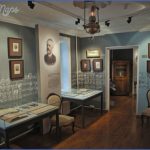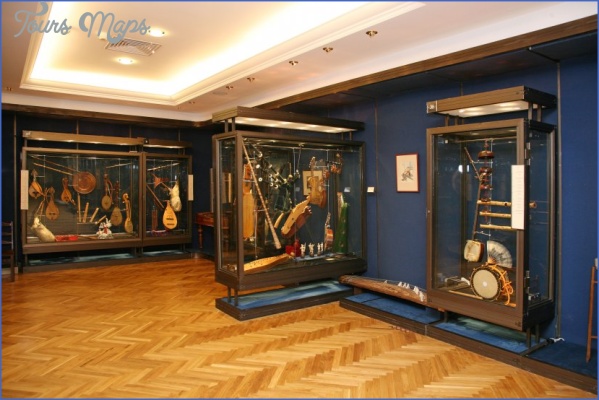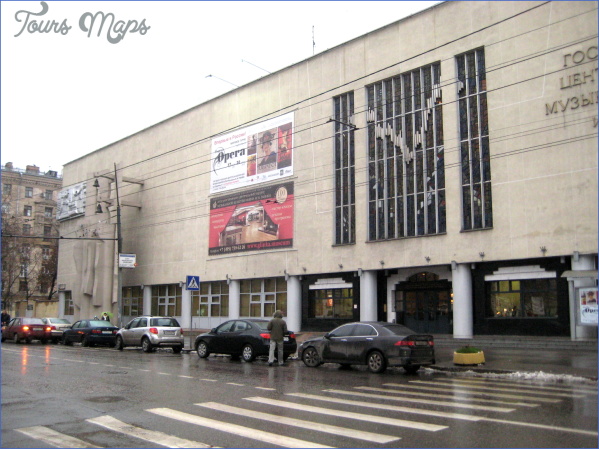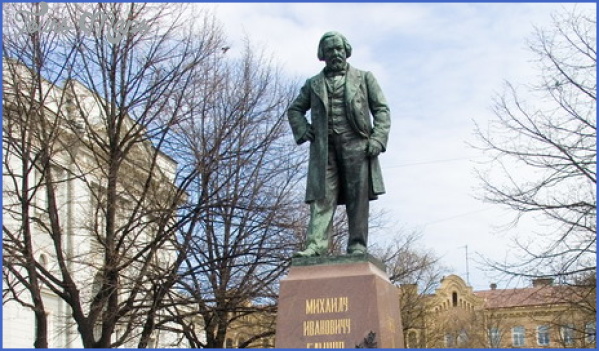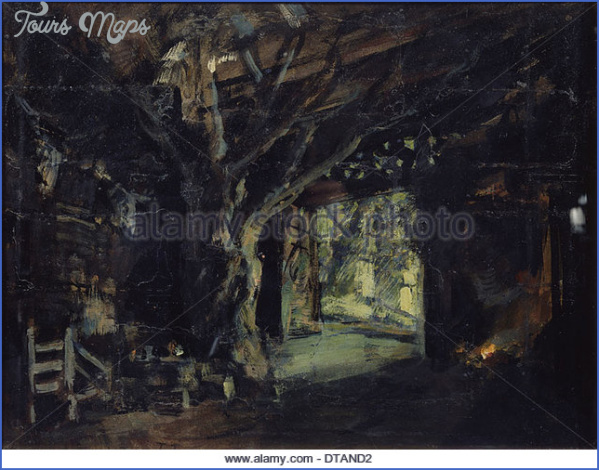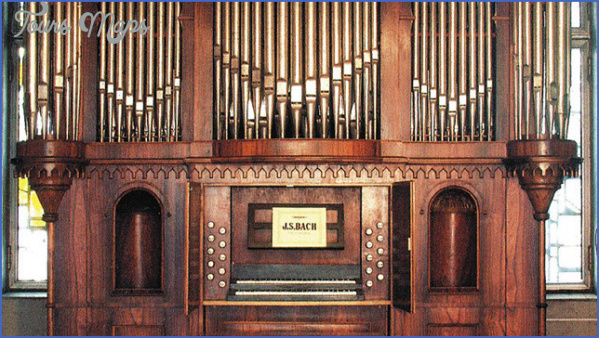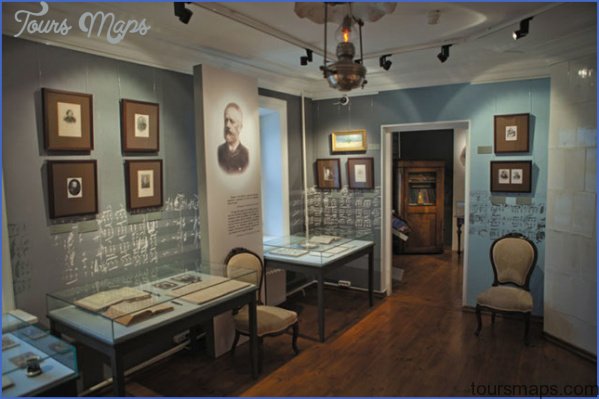GLINKA MUSEUM
Its remoteness should not deter admirers of Glinka’s music from visiting the museum at his birthplace in south-west Russia. Don’t assume that it is in the place called Glinka, although that village used to be part of the once vast and prosperous family estate. The museum is in the even smaller community of Novospasskoye, some way to the southeast, just east of the road linking Roslavl’ to Yelnya (some 60 km north of the former, 25 south of the latter), where the Glinkas lived for two centuries. Most visitors arrive in coach parties.
The house in which Mikhail Ivanovich Glinka was actually born on 1 June 1804 no longer exists. But a reconstruction of the large manor house built in 1810-14 by his father, Ivan Nikolayevich, does. (The house passed out of the family, was moved from the site and burnt down.) It is surrounded by a large, fenced park (damaged during World War II) and outbuildings, some of them built of logs, with a reservoir, ponds, bridges and follies. The only original building in the village is the recently restored blue, white and gold church, built by the composer’s grandfather in 1786; in the graveyard the parents and sister of Mikhail Ivanovich are buried. The Glinka museum opened in 1982, after six years of research and building, informed by the composer’s sister Natalya’s descriptions of the house and plans drawn up by his nephew who had also lived there; the displays benefit from the memoirs of more than 50 people who knew the man himself.
Mikhail Ivanovich spent his childhood at Novospasskoye and returned there for the summers while at school in St Petersburg (1817-22) and thereafter for occasional periods of musically fruitful refuge and recuperation (for example in summer 1823, after his father’s death in March 1834, after his marriage the following May and after its collapse in 1840, and finally for the winter of 1847-8). Soon after his birth he was put in the care of his grandmother, who has been blamed for his delicate health and chronic hypochondria; when she died in 1810 he was reunited with his parents, who employed a governess to supervise their 13 children. Music was part of the children’s studies and the family owned several pianos and employed 13 musicians; the young Glinka learned to play not only the piano but eventually the organ, violin, viola, guitar and flute as Rights were not granted to include these illustrations in electronic media, Please refer to print publication The Glinka museum at Novospasskoye well. A short distance away, his uncle kept his own serf orchestra, which entertained family and friends with the symphonies of Haydn, Mozart and Beethoven; after his studies in St Petersburg Mikhail Ivanovich was allowed to rehearse the orchestra.
GLINKA MUSEUM Photo Gallery
The 27-room house that his father built was spacious and light, with windows looking out on the park and french doors opening on to the rear terrace. A separate building could house as many as 100 guests at a time. The reception room walls were covered with velvet, the chandeliers were crystal and the furniture fashionable and well made. The Glinkas are said to have had 860 serfs and craftsmen maintaining the estate, which at the time included a large farm, a brick factory, an orchard of 340 apple trees, a vineyard and a greenhouse (where flowers and pineapples were grown). Craftsmen and women made carriages, carpets, lace and boots. Although no longer a working estate, it still offers a rare view of 19th-century privileged Russian country life.
The museum occupies 13 rooms – ten downstairs, three upstairs – which are guaranteed to surprise and delight. A remarkable collection of family furniture and furnishings has been assembled and displayed in the large central room (the ‘Celebration Room’), where there stands an elegantly finished Tischner grand piano (purchased by Glinka’s father, played by the composer) and, between the windows, two mirror tables, one of which contains a small square piano labelled ‘Buntebart et Freres, Princess Street and Hanover Square, 1785’; the dining-room, where in addition there is china that Glinka gave to his mother and an English grandfather clock stopped at 5 a.m. (the hour of Glinka’s death); the former billiard room; and the father’s bedroom, which has a larger square piano that the children played for him before retiring.
The best is saved for upstairs, where the indoor aviary the family kept is still home to 18 species of Russian singing birds – it is said that Glinka was so fond of the sound of birds that he had aviaries installed in his subsequent homes. Across the hall is his own rather grand bedroom, furnished with more family furniture as well as his Wirth grand piano, inlaid desk, travelling writing case and opera glasses. On the wall are paintings of Milan Cathedral, which he could see from the flat he rented there between 1830 and 1833, and a country scene including a tower with a space into which a working clock could actually be inserted (Glinka supposedly took this picture with him on his travels round Europe).
Display rooms on the ground floor tell the stories of the estate and the composer. Two former bedrooms chronicle Glinka’s career with autograph manuscripts, rare editions with signed title-pages, copies of landscapes that he drew, portraits (some engraved and signed by the composer, others merely copies) and views of places associated with him. Special attention is given to his music – and in particular his opera A Life for the Tsar, or Ivan Susanin, which had its premiere in St Petersburg in 1836 -and to the history of Glinka’s commemoration. There are busts, statues and reliefs, caricatures and reproductions of portraits. There are photographs of the house in Berlin where he died on 15 February 1857 (it was at one time marked by a plaque) and his temporary grave in the Russian cemetery, and of monuments put up in Smolensk in 1885 and St Petersburg in 1906. Finally, there are displays covering the creation of the museum, the annual Glinka Festival (held every June in Smolensk and at Novospasskoye since 1954) and the biennial International Glinka Prize for Singers – the winner always presents a recital in the concert hall upstairs in the museum, although the competition used to be held each time in a different capital of the Russian republics.
Glinka is buried in the musicians’ section of Tikhvin Cemetery in St Petersburg. Two concert halls there bear his name: the Little Glinka Hall at Nevsky Prospect 30 and the Glinka Kapella
Choral Hall at Nab. Reki Moiki 20. The primary musical museum in Russia, the Glinka State Central Museum of Musical Culture at Fadeyeva ulitsa 4, Moscow, with an important instrument collection and concert hall, is also named after the ‘Father of Russian Music’.
Maybe You Like Them Too
- Top 10 Islands You Can Buy
- Top 10 Underrated Asian Cities 2023
- Top 10 Reasons Upsizing Will Be a Huge Travel Trend
- Top 10 Scuba Diving Destinations
- World’s 10 Best Places To Visit

